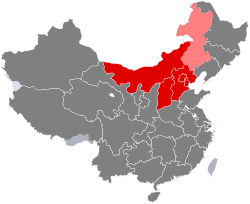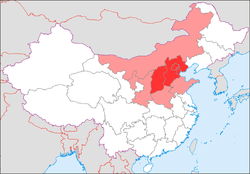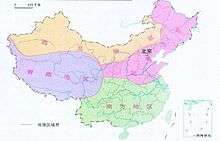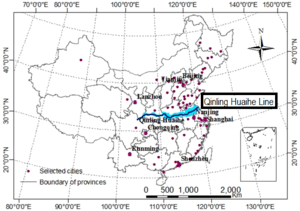North China
| North China | |
|---|---|
 Northern People's Republic of China region | |
| Area | |
| • Total | 2,185,105 km2 (843,674 sq mi) |
| Population | |
| • Total | 164,823,136 |
| • Density | 75/km2 (200/sq mi) |


North China (simplified Chinese: 华北; traditional Chinese: 華北; pinyin: Huáběi; literally "China's north") is a geographical region of China, lying North of the Qinling Huaihe Line.[1]

The heartland of North China is the North China Plain, or the Yellow River Plain. North China is usually restricted to the northern part of China proper (inner China and excludes Xinjiang and often Manchuria and Northeast China.
The vast region in China from the Yellow River Valley south to the Yangtze River was the centre of Chinese empires and home to Confucian civilization. In prehistory and early history, the plain (Henan in particular) is considered the origin of Chinese civilization in official Chinese history. The region cultivated wheat, and most speak Northern Chinese (Mandarin), which includes Beijing dialect, which is largely the basis of Standard Chinese (Mandarin), the official language of the People's Republic of China (PRC). Jin Chinese and Mongolian are also widely spoken. The region remains the political, military, and cultural center of the PRC.
History
In prehistory, the region was home to the Yangshao and Longshan cultures. Peking man was found near modern-day Beijing (Peking).
Administrative divisions in the PRC
| GB[2] | ISO №[3] | Province | Chinese Name | Capital | Population¹ | Density² | Area³ | Abbreviation/Symbol |
|---|---|---|---|---|---|---|---|---|
| BJ | 11 | Beijing Municipality | 北京市 Běijīng Shì |
Beijing | 19,612,368 | 1,167.40 | 16,800 | 京 Jīng |
| TJ | 12 | Tianjin Municipality | 天津市 Tiānjīn Shì |
Tianjin | 12,938,224 | 1,144.46 | 11,305 | 津 Jīn |
| HE | 13 | Hebei Province | 河北省 Héběi Shěng |
Shijiazhuang | 71,854,202 | 382.81 | 187,700 | 冀 Jì |
| SX | 14 | Shanxi Province | 山西省 Shānxī Shěng |
Taiyuan | 35,712,111 | 228.48 | 156,300 | 晋 Jìn |
| NM | 15 | Inner Mongolia Autonomous Region Nei Mongol Autonomous Region |
內蒙古自治区 Nèi Měnggǔ Zìzhìqū |
Hohhot | 24,706,321 | 20.88 | 1,183,000 | 蒙(內蒙古) Měng (Nèi Měnggǔ) |
Cities with urban area over one million in population
Provincial capitals in bold.
| # | City | Urban area[4] | District area[4] | City proper[4] | Prov. | Census date |
|---|---|---|---|---|---|---|
| 1 | Beijing | 16,446,857 | 18,827,262 | 19,612,368 | BJ | 2010-11-01 |
| 2 | Tianjin | 9,562,255 | 11,090,783 | 12,938,693 | TJ | 2010-11-01 |
| 3 | Taiyuan | 3,154,157 | 3,426,519 | 4,201,592 | SX | 2010-11-01 |
| 4 | Shijiazhuang | 2,770,344 | 2,834,942 | 10,163,788 | HE | 2010-11-01 |
| 5 | Tangshan | 2,128,191 | 3,187,171 | 7,577,289 | HE | 2010-11-01 |
| 6 | Baotou | 1,900,373 | 2,096,851 | 2,650,364 | NM | 2010-11-01 |
| 7 | Hohhot | 1,497,110 | 1,980,774 | 2,866,615 | NM | 2010-11-01 |
| 8 | Datong | 1,362,314 | 1,737,514 | 3,318,054 | SX | 2010-11-01 |
| 9 | Handan | 1,316,674 | 1,445,338 | 9,174,683 | HE | 2010-11-01 |
| 10 | Baoding | 1,038,195 | 1,138,521 | 11,194,382 | HE | 2010-11-01 |
See also
References
- ↑ Shuangshuang, LI; Saini, YANG; Xianfeng, LIU (10 September 2015). "Spatiotemporal variability of extreme precipitation in north and south of the Qinling-Huaihe region and influencing factors during 1960-2013". The Chinese journal of geography. 34 (3): 354–363. Retrieved 25 May 2017.
- ↑ GB/T 2260 codes for the provinces of China
- ↑ ISO 3166-2:CN (ISO 3166-2 codes for the provinces of China)
- 1 2 3 国务院人口普查办公室、国家统计局人口和社会科技统计司编 (2012). 中国2010年人口普查分县资料. Beijing: 中国统计出版社 [China Statistics Press]. ISBN 978-7-5037-6659-6.